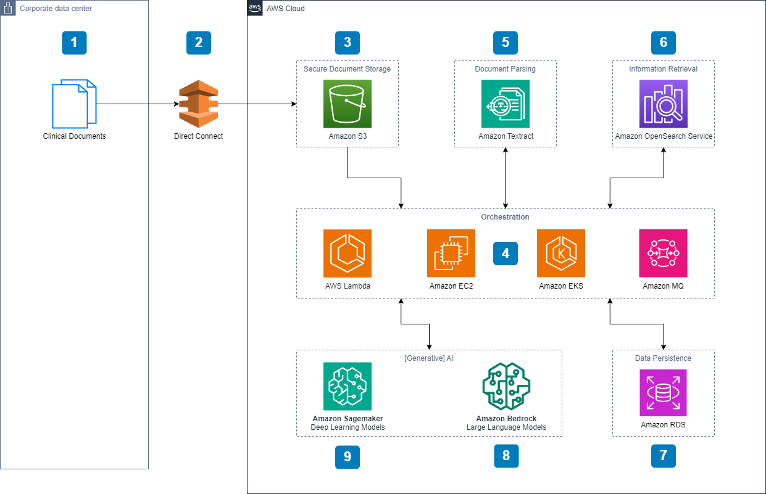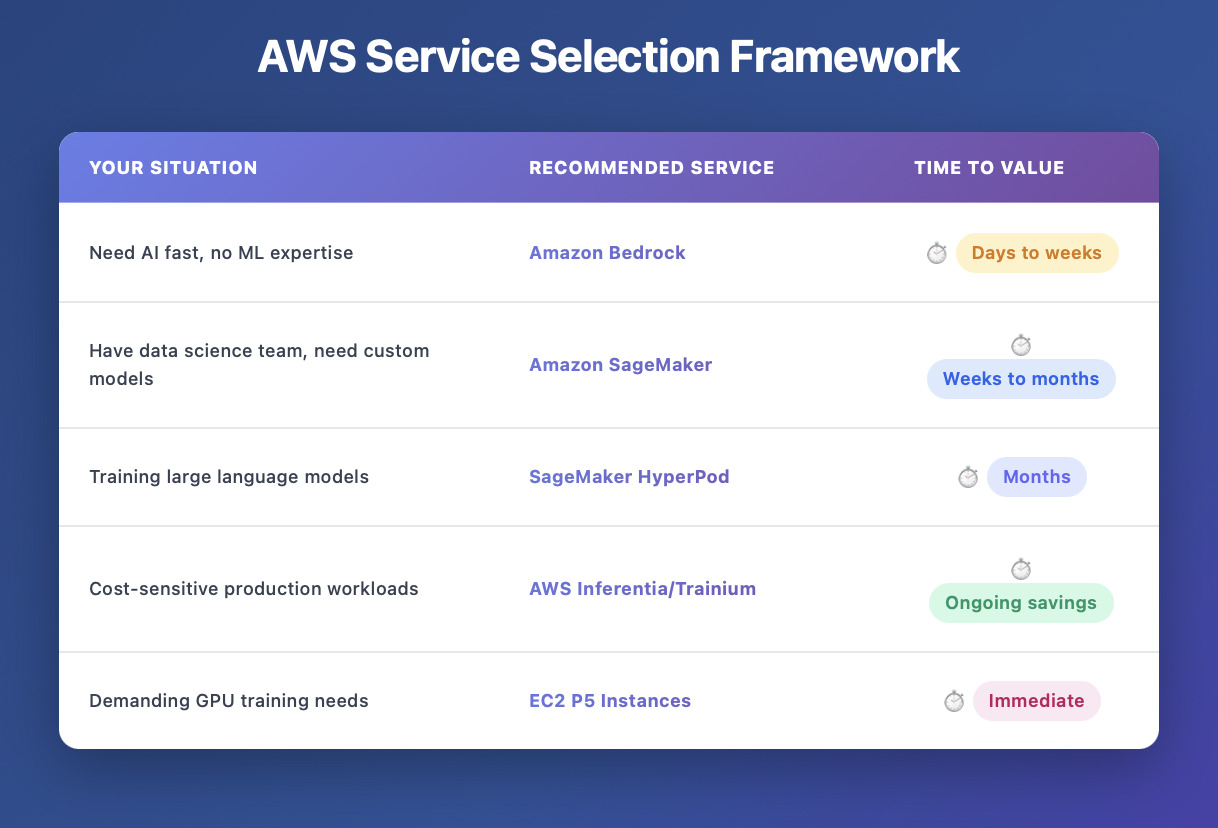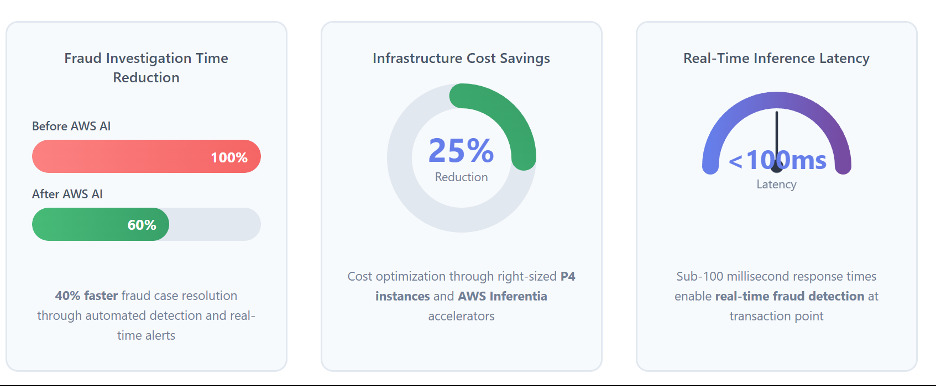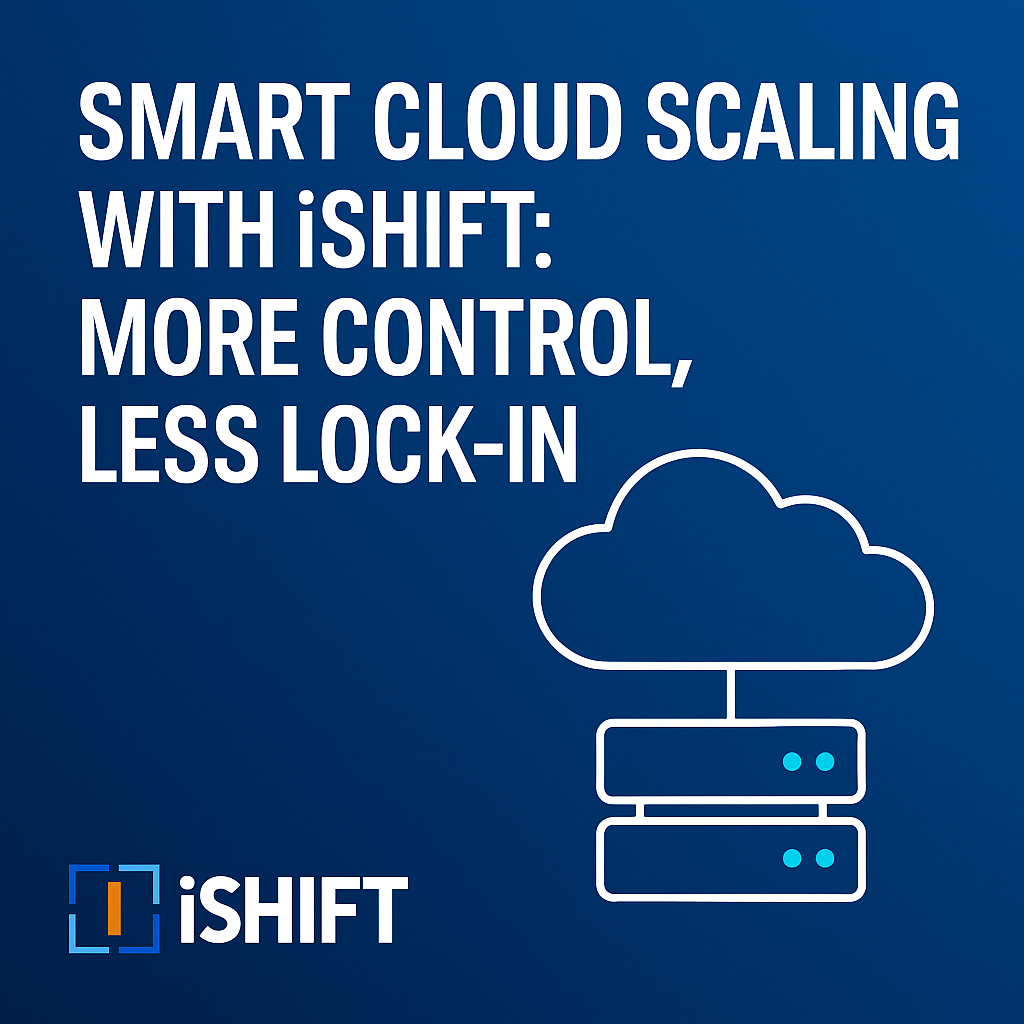Practical strategies for integrating AI/ML into your AWS cloud environment without compromising cost, security, or agility
iShift • October 2025 • 8-minute read
At a Glance
Generative AI is reshaping how businesses compete. However, deploying it successfully on AWS requires more than spinning up GPU instances. This guide walks you through proven strategies for integrating AI workloads while maintaining security, controlling costs, and delivering measurable business impact. It covers quick-win pilots using Amazon Bedrock to enterprise-scale MLOps platform scenarios.
Key Takeaway
Start with pre-trained foundation models to prove value in weeks, then scale to custom solutions as your needs mature.
Who Should Read This
- CTOs and Engineering Leaders planning AI adoption roadmaps
- Cloud Architects designing secure, scalable AI infrastructure
- Data Science Teams ready to move from experimentation to production
- FinOps Professionals managing AI/ML cloud costs
- Compliance Officers ensuring AI governance and regulatory adherence
Table of Contents
1. Why AI in the Cloud Matters Now
2. 4 Core Strategies for AWS AI Integration
3. AWS AI Services: Which One to Choose
4. Real-World Results: Financial Services Case Study
5. Your 5-Step Implementation Roadmap
6. Common Questions Answered
Why Generative AI in the Cloud Matters Now
Your competitors are already using AI to win customers.
While you’re reading this, companies in your industry are deploying chatbots that resolve customer issues in seconds, fraud detection systems that catch threats in real-time, and predictive models that optimize supply chains automatically. According to Gartner, 74% of executives say generative AI will be critical to their competitive advantage within the next 2 years.
But here’s the challenge: AI isn’t just another cloud workload.
Unlike traditional applications, AI demands careful orchestration of GPU resources, strict data governance, seamless integration with existing systems, and constant monitoring for model drift. Done right, AI/ML on AWS becomes a force multiplier for innovation. Done poorly, it creates runaway costs, security vulnerabilities, and compliance headaches.
This guide shows you how leading organizations are deploying AI on AWS successfully—and how you can too.

End-to-end AWS AI/ML architecture showing data ingestion, model training, and inference deployment
4 Core Strategies for AI/ML Integration on AWS
1. Assess and Prioritize AI Use Cases
Not all AI initiatives deliver equal ROI. Start with the end in mind.
The right way to prioritize:
- Business impact first: Will this reduce costs, increase revenue, or improve customer satisfaction?
- Data availability second: Do you have quality data to train models?
- Complexity third: Can pre-trained models solve this, or do you need custom development?
High-ROI starting points:
- Customer service automation (chatbots, ticket routing)
- Fraud detection and anomaly monitoring
- Content generation for marketing teams
- Predictive maintenance for operations
- Supply chain optimization
Before building custom models, evaluate whether foundation models can solve your problem. Many organizations waste months building custom solutions when pre-trained models would deliver 80% of the value in 80% less time.
2. Leverage AWS-Managed Services
AWS offers AI/ML services for every maturity level: from zero-code solutions to fully customizable platforms. The key is to choose the right tool for your current stage.

The progression path most successful companies follow:
- Prove value with Bedrock (pre-trained foundation models)
- Scale with SageMaker (custom models + MLOps)
- Optimize with Inferentia/Trainium (cost-efficient inference)
3. Address Security and Compliance from Day One
Security isn’t an afterthought, it’s a foundation.
AI workloads often process your most sensitive data: customer personally identifiable information (PII), financial transactions, healthcare records, and proprietary business information. A breach here doesn’t just hurt your reputation—it can trigger massive regulatory fines.
Security checklist for AI workloads:
- Encryption: At rest (S3, EBS) and in transit (TLS)
- IAM controls: Principle of least privilege for model access
- VPC isolation: Keep training data off the public internet
- Compliance frameworks: HIPAA, GDPR, SOC 2, PCI-DSS alignment
- Model governance: Track model versions, training data, and deployment history
- Data lineage: Document where training data comes from and who accessed it
Critical mistake to avoid: Waiting until after your pilot succeeds to “add security later.” Retrofitting security into production AI systems is exponentially harder than building it in from the start.
4. Build Scalable Data Foundations
Your AI models are only as good as your data infrastructure.
The most common reason AI projects fail isn’t model performance. It’s data quality and availability. Before training your first model, ensure you have a robust data pipeline that can handle both batch training and real-time inference.
Essential AWS data infrastructure:
For batch model training:
- Amazon S3: Scalable data lake storage with lifecycle policies
- AWS Glue: Serverless ETL for data prep and cataloging
- AWS Lake Formation: Centralized governance and access control
For real-time inference:
- Amazon Kinesis: Streaming data ingestion (transactions, IoT sensors, logs)
- DynamoDB: Low-latency feature store for real-time lookups
- API Gateway: Managed inference endpoints
Pro tip: Separate your training data pipeline from your inference pipeline. Training can tolerate minutes of latency; inference often needs sub-100ms response times.
AWS AI Services Deep Dive: Which One Should You Choose?
Amazon Bedrock: The Fast-Track Option
Best for: Teams that need AI functionality quickly without ML expertise.
Bedrock provides access to pre-trained foundation models from Anthropic (Claude), Meta (Llama), Stability AI, and others through a simple API. No infrastructure management, no model training, no GPU cluster configuration.
Use cases:
- Customer service chatbots
- Content generation (marketing copy, emails, summaries)
- Document analysis and extraction
- Code generation and review
Typical timeline: Proof of concept in 1-2 weeks
Amazon SageMaker: The Custom Solution Platform
Best for: Data science teams building custom models with specific business requirements.
SageMaker is a comprehensive ML platform with built-in algorithms, automated model tuning, MLOps capabilities, and managed deployment endpoints.
Key features:
- Built-in algorithms for common use cases (fraud detection, forecasting, recommendations)
- SageMaker Autopilot for automated model development
- SageMaker Pipelines for MLOps workflow orchestration
- Real-time and batch inference endpoints
- Model monitoring for drift detection
Typical timeline: First model in production in 6-12 weeks
Purpose-Built Infrastructure: Optimizing for Scale
Once you’re running AI in production, infrastructure costs matter.
AWS Inferentia and Trainium chips:
- Purpose-built ML accelerators
- Up to 50% cost savings vs. GPU-based inference
- Designed specifically for transformer models
EC2 P5 instances:
- NVIDIA H100 GPUs for demanding workloads
- Recent price reductions up to 45%
- Ideal for training large language models
Cost optimization tools:
- AWS Compute Optimizer: Identify underutilized GPU resources
- Spot Instances: Save up to 90% on training jobs
- Savings Plans: Commit to usage for predictable discounts
Real-World Example: Accelerating AI in Financial Services
A global financial services firm needed to detect fraudulent transactions in real-time—without disrupting legitimate customer purchases.
Their AWS architecture:
- Amazon S3: Data lake storing historical transaction data
- Amazon Kinesis: Real-time streaming of new transactions
- Amazon SageMaker: Custom fraud detection models with real-time inference endpoints
- AWS Lambda: Serverless processing for lightweight transformations
Results achieved:

Key success factors:
- Started with a well-defined use case with clear ROI
- Built security and compliance into the architecture from day one
- Used managed services (SageMaker) to accelerate time-to-production
- Implemented automated model retraining to maintain accuracy
Practical Next Steps: Your 5-Step Implementation Roadmap
Step 1: Conduct an AI Readiness Assessment
Before you build anything, understand where you are today.
Evaluate:
- Data maturity: Do you have clean, accessible data?
- AWS infrastructure: What’s already in place?
- Team capabilities: Do you have ML expertise or do you need partners?
- Compliance requirements: What regulations apply to your industry?
Timeline: 1-2 weeks
Outcome: Clear understanding of gaps and dependencies
Step 2: Start with a Contained Pilot
Choose a high-impact, low-complexity use case for your first project.
Recommended pilots:
- Generative chatbot using Amazon Bedrock (no ML expertise required)
- Anomaly detection using SageMaker built-in algorithms
- Document processing with Amazon Textract + Bedrock
Success criteria: Demonstrate measurable business value in 4-8 weeks
Step 3: Build a Phased Roadmap
Don’t try to solve everything at once. Scale systematically.
Phase 1 (Weeks 1-4): Single use case with Amazon Bedrock
- Prove that AI can solve a real business problem
- Establish security and governance baseline
- Get stakeholder buy-in
Phase 2 (Months 2-3): Custom model development with SageMaker
- Build models tailored to your specific data
- Implement automated model evaluation
- Deploy real-time inference endpoints
Phase 3 (Months 6-12): Enterprise MLOps platform
- Automated model retraining pipelines
- Comprehensive model governance and monitoring
- Multi-team collaboration on shared infrastructure
Step 4: Align AI KPIs to Business Outcomes
Don’t measure success by model accuracy alone—measure business impact.
Track metrics like:
- Customer retention improvement
- Operational cost savings (reduced manual work)
- Revenue per customer increase
- Time-to-market acceleration
- Error rate reduction in critical processes
Example: Instead of “Our model achieves 94% accuracy,” report “Our AI reduced customer service costs by $2M annually while improving satisfaction scores by 15%.”
Step 5: Implement FinOps for AI
AI workloads can spiral out of control cost-wise if left unmanaged.
Cost control tactics:
- AWS Cost Explorer: Identify cost trends and anomalies
- Savings Plans & Reserved Instances: Commit to usage for 30-70% discounts
- AWS Budgets: Set up alerts for GPU cost overruns
- Spot Instances: Use for interruptible training jobs
- Automated shutdown: Turn off dev/test environments after hours
Cost optimization checklist:
- [ ] Right-size your instances based on actual usage
- [ ] Delete unused SageMaker endpoints
- [ ] Move infrequent data to S3 Glacier
- [ ] Use Inferentia/Trainium for production inference
- [ ] Schedule training jobs during off-peak hours when possible
💡 Pro Tip: The Fastest Path to Value
Start with Amazon Bedrock’s pre-trained foundation models to demonstrate value in weeks, not months. Once you’ve proven the business case and built internal ML capabilities, progress to SageMaker for custom models. This approach minimizes time-to-value while building the skills and infrastructure you’ll need for long-term success.
Why this works: Executives want to see results fast. A working Bedrock-powered chatbot that saves your support team 10 hours per week is worth more than a theoretical custom model that might be ready in six months.
Common Questions Answered
1. How much does AI on AWS actually cost?
It varies dramatically based on your approach. A simple Bedrock-powered chatbot might cost $500-2,000/month, while training large custom models on SageMaker can cost $10,000-100,000+ per training run. The key is starting small, measuring ROI, and scaling what works.
Cost control strategies:
- Start with Bedrock (pay-per-API-call, no infrastructure)
- Use Spot Instances for training (up to 90% savings)
- Deploy production models on Inferentia (50% cheaper than GPUs)
- Implement automated cost alerts and budgets
2. Do we need a data science team to get started?
No, you don’t if you start with Amazon Bedrock. Bedrock provides pre-trained models accessible via simple API calls that require only basic software engineering skills. As you scale to custom models with SageMaker, you’ll need ML expertise. You can accomplish this either by hiring talent, upskilling, or working with an AWS partner such as iShift.
3. How do we ensure our AI models are secure and compliant?
Security must be built in from day one, not added later. Key requirements:
- Encrypt all data (S3, EBS) at rest and in transit
- Use VPC isolation to keep training data off the public internet
- Implement IAM least-privilege access controls
- Enable CloudTrail for audit logging
- Document data lineage and model governance
For regulated industries (healthcare, finance), work with AWS compliance programs like HIPAA, PCI-DSS, and SOC 2 from the start.
4. How long does it take to see results?
Quick wins (2-4 weeks): Bedrock-powered chatbot or document processing
Production models (2-3 months): Custom SageMaker models with real-time inference
Enterprise MLOps (6-12 months): Automated retraining, governance, multi-team platform
The key is starting with high-impact, low-complexity use cases that prove value quickly, then reinvesting those wins into more sophisticated capabilities.
5. What if our data isn’t ready for AI?
This is the #1 blocker for most organizations. Before investing heavily in AI, ensure you have:
- Data quality: Accurate, complete, consistent records
- Data accessibility: Centralized storage (S3 data lake)
- Data governance: Clear ownership and lineage tracking
If your data isn’t ready, start there. Even basic data cleanup and centralization will pay dividends far beyond AI use cases.
6. Can we start with on-premises AI and migrate later?
You can, but it’s rarely the best path. On-premises AI requires significant upfront infrastructure investment (GPU clusters, storage, networking) and ongoing maintenance. AWS offers:
- Elastic scaling: Pay only for what you use
- Managed services: Let AWS handle infrastructure
- Latest hardware: Access to newest chips (Inferentia, H100 GPUs)
- Global reach: Deploy models worldwide
Unless you have strict data residency requirements, starting in AWS will accelerate your timeline and reduce risk.
Ready to Scale AI Securely on AWS?
Deploying AI successfully isn’t about having the best algorithms. It’s about having the right strategy, architecture, and partnerships.
iShift helps enterprises accelerate their AI journey on AWS with:
- AI readiness assessments and roadmap development
- Secure, scalable architecture design
- Pilot implementation and production deployment
- MLOps platform setup and team training
- Ongoing optimization and cost management
Unsure how to start? Schedule a consultation with our AWS AI experts to discuss your specific use case and get a customized roadmap.
Schedule Your Free Consultation →



